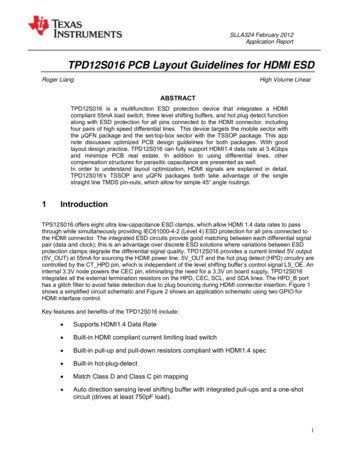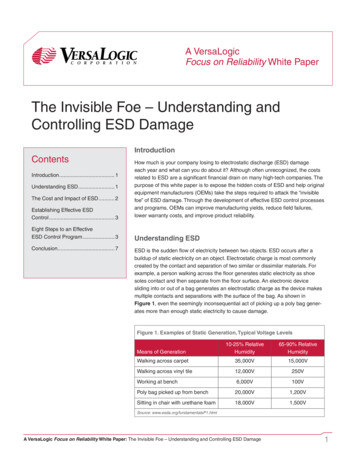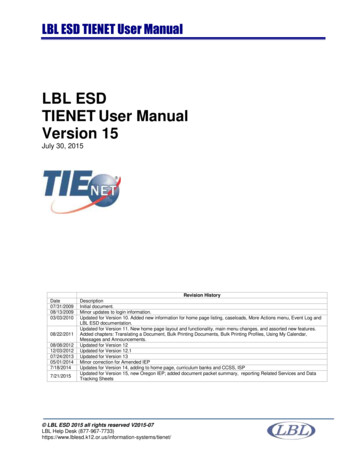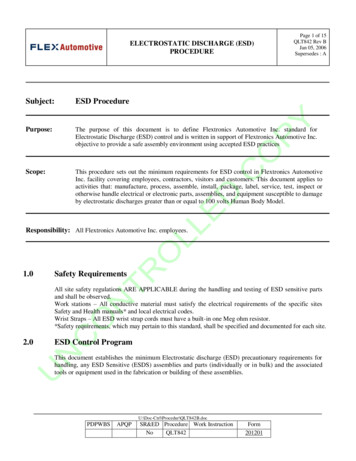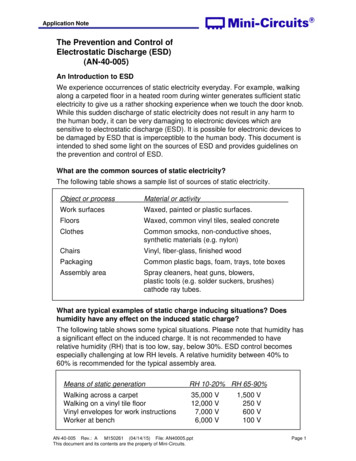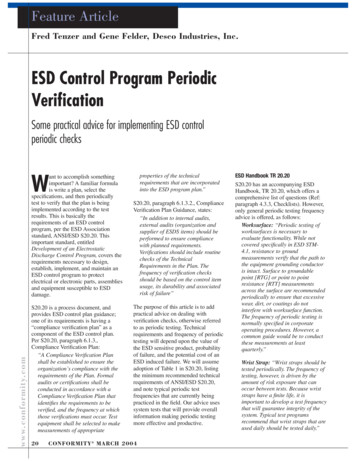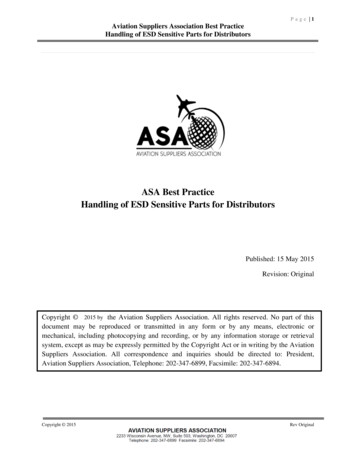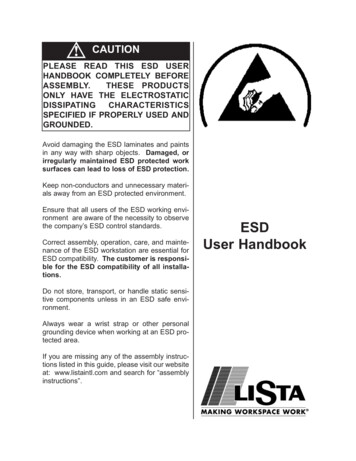
Transcription
ESD – BOOK
ESD BOOKProtection from electrostatic discharges in the electronic environmentsPrefaceThis publication is intended to help users in understanding and prevent the ElectrostaticDischarges Phenomena, it is not a substitute for reference to the ESD or SafetyStandards The information given in this ESD BOOK is based on CEI/IEC 61340-5-1:1998 and CEI/IEC 61340-5-2/TS:1999 published by the International ElectrotechnicalCommission, 3, rue de Varambe, Geneva, Switzerland. (www.iec.ch).It is recommended to buy the IEC 61340-5-1 Technical Report and IEC 61340-5-2Technical Specification, or their national versions, as IEC documents, they have worldwide applicability.StandardsIEC 61340-5-1:Protection of electronic devices from electrostatic phenomena– General requirements (1999)IEC 61340-5-2:Protection of electronic devices from electrostatic phenomena– User Guide (1999)IEC 61340-4-1:Electrical resistance of floor coverings and installed floorsANSI/ESD S20.20-1999: Protection of Electrical and Electronic Parts, Assemblies andEquipment USA 1999 (download free in pdf format, sourcewww.esda.org)ANSI/ESD S541-2003:Packaging Materials for ESD Sensitive Items USA - 2003(download free in pdf format, source www.esda.org)
What is ESD?Electrostatic discharge is defined as the transfer of charge between bodies at differentelectrical potentials. The electrostatic charge occurs when two different materials rub orslide together or are separated.Examples are: walking over synthetic floors, rubbing of synthetic garments, shifting ofplastic boxes, unrolling of PVCadhesive tape, moving of conveyor beltWhen two objects with different chargesget closer, electrons can suddenly flowfrom one object to the other.ESD can also occur when a high electricfield develops between two objects in closeproximity.ESD can results in:Static generation typical voltage levelsMeans of generation10-25% RH65-90% RHWalking across carpet35000 Volt1500 VoltWalking across vinyl tile12000 Volt250 VoltWorker at bench6000 Volt100 VoltPoly bag picked up from bench20000 Volt1200 VoltChair with urethane foam18000 Volt1500 VoltDevice typeESD susceptibilityCMOS250 - 3000 VoltOP-AMP190 - 2500 VoltVMOS30 - 1800 VoltMOSFET100 - 200 VoltGaAsFET100 - 300 VoltEPROM100 VoltJFET140 - 7000 VoltBI-POLAR TRANSISTOR380 - 7000 VoltSCHOTTKY DIODES300 - 2500 VoltSCHOTTKY TTL1000 - 2500 Volt
MaterialsFor ESD purposes, many materials are classified by their resistance or resistivitycharacteristics.Shielding materialsfrom 0 to 10 3 ΩConductive materialsfrom 0 to 10 5 ΩStatic-Dissipative materialsform 10 5 to 10 12 ΩInsulative materials 10 12 ΩSurface resistance measurements are not always appropriate to establish theeffectiveness of the materials, where resistance is higher than 10 10 Ω, or where thematerial is of non-homogeneous woven it is mandatory to measure the “decay time ofthe generated charge”SHIELDING MATERIALS: providing a Faraday cage protection, limit the passage ofcurrent and attenuate the energy resulting from an electrostatic discharge. Most staticshielding materials include a conductive (less than 10 3 Ω) metal or carbon element thatsuppresses the field, attenuates, or reflects field energy.CONDUCTIVE MATERIALS: characterised by a low electrical resistance (less than10 5 Ω), allow the charge to quickly distribute itself throughout the material. If theconductive material is connected to ground, all charge will flow away. Some examples ofconductors are metals, carbon and the human body's sweat layer.STATIC-DISSIPATIVE MATERIALS: are defined as those having a surface resistancegreater than 10 5 Ω but less than 10 12 Ω. Charges will flow to ground slower than withconductive materials, reducing its destroying potential.INSULATIVE MATERIALS: are defined as those having a surface resistance of at least10 12 Ω. Insulative materials have a high electrical resistance and are difficult to ground.Static charges remain in place on these materials for a very long time. This propertymake insulators a hazard that must be controlled as part of an ESD program. Someexamples of insulators are common plastics, glass and air.
ControlsESD damage can occur at any time:GOODS CKINGSHIPPINGMAINTENANCEBasic ESD controls:GROUNDINGSHIELDINGNEUTRALIZATION (ionizers)4 gold rules:1. Assume that all active components are sensitive to ESD2. Handle electronic components only in the ESD protected area (EPA) and onlywhen you are properly grounded.3. Store and transport the ESD-sensitive items in ESD protective containers.4. Check regularly the ESD protection system, internal and external (suppliers)Take in evidence the principle "No Charge/No discharge", the elimination of chargebuild-up is obtained by using conductive and dissipative materials that have lesstendency to generate static charges. All equipment must be free of moving parts thatmay generate charges, e.g., rubber rollers, plastic stoppers, etc. Things which thedevices may come in contact with or get transported onmust also be antistatic orconductive. The use of ionizers to neutralize newly generated charges will also preventcharge build-up. The minimization of movements in the work area, as well the use ofESD-safe equipment, will help in minimizing static charges generated by personnel.
EPA areaAn EPA (ESD Protected Area) is a defined space where no items or activity are able tocause damage to a sensitive device.In the simplest case - a field work station - it may consist of a dissipative mat, a wriststrap and common grounding facility for both.1) Groundable castors2) Groundable surface3) Wrist-strap tester4) Footwear tester5) Footwear foot plate6) Wrist cord and wrist band7) Ground cord8) Ground9) Earth Bounding Point (EBP)10) Groundable point of trolley11) Toe and heel strap (footwear)12) Ionizers13) Static-dissipative working surface14) Seat with groundable feet and pads15) Static-dissipative floor16) Low charging garments17) Shelvings with grounded surfaces18) EPA sign
Typical workstation: Remove all extraneous materials from the workstation (food, beverages, combs, bags,clothing etc). Test the wrist strap/operator daily or install constant monitors. Inspect theESDgrounding connections, the mats, the EBP,weekly. Clean the surfaces with purpose-made antistatic cleaner, do not use commercialproducts, the cleanersmay leave a residue insulative layer.
GroundingPeople are the primary source of electrostatic chargesThe elimination of charge build-up is obtained by using conductive and dissipativematerials that have less tendency to generate static charges. Grounding systems shallbe used to ensure that components, personnel and any other conductors are at thesame electrical potential. For proper and safe grounding the ESD ground must be tieddirectly to and at the same potential as the building or "green/yellow" ground.Personnel grounding devices:WRISTSTRAPThe wrist strap is the most used device to ground personnel, it will safelyand effectively drain static charges from the body. Someone offers ESDWrist straps without cord (cordless), we can assure that are ineffective.FOOTWEAR In some locations, such as stores and around equipment, conductiveshoes or foot grounders are used. Foot grounders should be worn onboth feet to ensure constant contact to ground floor or floor mat. Footgrounders will not function properly if used on surfaces which areinsulative or improperly grounded.GARMENTSThe main purpose for wearing conductive smocks is to suppress staticfields on employee clothing. The conductive fibers woven into thematerial provide a Faraday cage that prevents dangerous fields fromextending to and damaging sensitive products. There shall be electricalconductivity between all parts of the garment.GLOVESESD sensitive device can experience a damaging discharge if touchedby a person, even if that person is properly grounded. Increasing theelectrical path's contact resistance is one way to control the speed of thedischarge. A good way to accomplish this is by wearing static dissipativecots and gloves.CHAIRSThe resistance to ground from any part of the seat which may havecontact with personnel, must be less than 10 10 Ω. At least two castorsor feet must provide a path to ground.
LabelsBasic symbolThe basic symbol consists of a yellow hand within a blacktriangle. It is intended to identify devices and assemblieswhich are ESD sensitive.Protection symbolUsed to designate all ESD protective products such as bags,boxes, garments. A letter is added under the symbol toindicate the primary function:CConductiveDDissipativeSShieldingLLow chargingEPA SymbolUsed to designate EPA equipments such as tables, trolleys,chairs.EPA cautionary symbol
Earth Bonding Point (EBP)EPA warning signEPA which contain high voltageThe signs are designed to attract attention and deliver a clear message to personnel andvisitors before they enter the EPA.Where high voltages greater than 250VAC or 500VDC are present, use proper warningsigns.
Field worksField work is perhaps the most risky situation of handling ESD sensitive devices, it isalso often the most neglected aspect of ESD damage prevention. The situation is riskyas there are usually many potential ESD sources in the environment. Spare parts shouldbe transported inside static shielding bags or containers . Where modules have to beworked on in an exposed state, staticdissipativematting should be bonded to the product's electrostatic bonding point, and to the groundto act as awork surface.Typical field service kit:- Wriststrap with 1MΩ resistor w. coiled cord- Static dissipative mat- Grounding cord with 1MΩresistor built-in- Lay ESD sensitive devices only on the matPackagingThe aim of ESD protective packaging is to prevent a direct electrostatic discharge to theESDS item contained within and allow for dissipation of charge from the exterior surface.Packaging material will also often provide mechanical protection and protection againstcontamination by dust or humidity.IEC 61340-5-1 defines three levels of packaging:INTIMATE in contact with the ESDS.PROXIMITY' does not make contact with the ESDS, but mayenclose one or more ESDSSECONDARY mainly used to give physical protection, is kept awayfrom ESDS and is not allowed in the EPA
INSIDE TEH EPAINTIMATEEither lowcharging andconductive or lowcharging andstatic-dissipativeESDSNOTESDS(for poweredESDS only lowcharging andstatic-dissipativeabove 1GΩ shallbe used)OUTSIDE THE EPAPROXIMITY'INTIMATEPROXIMITY'Low charging andelectrostaticshielding or lowcharging andconductive orstatic-dissipative.As for inside EPAElectrostaticshieldingDissipative or low chargingNo requirementsNote: where surface resistance 10 10 Ω is used, the material shall be procured with aT1000 2 secCaution in purchasing:some packaging materials may be humidity dependent and may have limited shelf life,some other may contaminate or shed particles that cause production-related problems.(example: a too brittle hard foam).BagsBags are classified in:ANTISTATIC (low charge)Use: Within the EPA for packing non-ESD sensitive itemsCost: Low.Appearance: Clear or tinted (pink, blue, green)Material: Polyethilene mono or multilayer.Characteristics: 10 10 - 10 12 Ω. - T1000 2sec a 50% rH e 22 CShelf-life: Generally 1 year.
CONDUCTIVEUse: Good degree of protection for many ESD sensitive items. Don't use with powereddevices.Cost: Medium.Appearance: Black.Material: Polyethilene with carbon added.Characteristics: 10 3 - 10 5 Ω.Shelf-life: More than 5 years.SHIELDINGUse: For intimate packaging of all ESD sensitive itemsCost: High.Appearance: Metallized semi-transparent.Material: Generally a vacuum deposited aluminium between layers of polyesther andpolyethilene filmCharacteristics: Shielding bags meet the two main requirements: "low charging" and"electrostatic discharge shielding barrier"Shelf-life: More than 2 years.IonizationWhere grounding of some equipment or parts of it through the traditional earthingtechniques is impractical and where it is impossible to exclude all charging materialsfrom the working area, the use of suitable ionizers is highly.Air Ionization systems work by flooding the atmosphere with positive and negative ions.When the ionized air comes in contact with a charged surface, the surface attracts ionsof the opposite polarity.As a result the static electricity that has built up on products andequipment is neutralised. Ions do remove small particles or smoke and pollens from theair, and subjective research suggest that peopleworking in ionized area are happier.NUCLEAR: High maintenance requiredAC: Low discharge time when using high volume blowersDC: Very Lowdischarge time.LOCAL (little ares): bench Ionizers, Ionizing bars, Ionizing guns.COMPLETE (whole room): Manual Environmental Control and Automatic EnvironmentalControlMaximum Ozone generation accepted by law: 0.2 mg/m 3 (0.1ppm)DC Ionizers with balanced ions emission are the best solution for local protection.
An ionization test kit can very quickly verify the proper functioning of an ionizer. Theionization test kit should be grounded and placed in the ionized airflow to measure thedecay time and the balance of air ionization equipment, the charger is used to charge anisolated plate applied on the field-meter.HumidityThe most significant environmental factor in ESD Control is the relative humidity (Rh).When humidity in the working environment decreases, the human body and otherinsulators can easily charge with static electricity due to friction. The air itself, being dry,becomes a part of the electrostatic build-up mechanism, every time an air flow(wind, airconditioning, blower) come over an insulated surface. Relative Humidity shall bemaintained over 30%.Below that value it is recommended the use of ionization.Environmental Monitoring.Each EPA area shall be equipped with a Humidity / Temperature meter to record thesedata.These informations are useful to establish the distribution through the timeofESDrelated failures (needed to the "Failure Process Analysis").
MonitoringESD protection systems as wrist straps, foot grounders, work surfaces and floors needto be checked on a regular basis. This is an important requirement of the ESD standardIEC 61340-5-1.PERSONNEL TESTINGThe personnel grounding tester is a wrist strap and/or footwear tester to checkpersonnel grounding systems before entering an EPA.Check wrist straps and footwear twice a day.FOR STANDING OPERATIONSESD flooring used with approved footwear,may be an alternative to the wrist strapsystem, in this case the standard is more restrictive and one of the followingconditionsmust be met:- the resistance of the person to the ground must be less than 3.5x10 7 Ω- the maximum body voltage generation must be less than 100 volts.It is easier to check the first condition, we suggest to use a Megaohmmeter with onelead attached to the ground and one electrode held by the person wearing ESDfootwearstanding on the factory's protective floor.GARMENTSRsup 10 12 Ω and charge decay T1000 2secGLOVES AND FINGER COATS AS WORN750 KΩ Rg 10 12 Ω
EPA TESTINGWorksurface: 750 KΩ Rg 10 9 ΩFloors: Rg 10 9 ΩChairs: Rg 10 10 ΩTools: Rg 10 12 ΩSafetyBefore we get to the key issues of ESD control, it is important to note that personnelsafety is paramount. In no way should an ESD control program replace or supersedeany requirements for personnel safety.In the factory, grounding personnel around the AC power line is a possible hazard.Personal grounding should not be used when working around voltages greater than250VAC.Although personal grounding items must include a 1MΩ resistor to limit current to lessthan 0.25 mA, ground fault circuit interrupters should be used.Where high voltages greater than 250VAC or 500VDC are present, use proper warningsigns.
TrainingSTANDARDS: purchase, read and get familiar with the IEC 61340-5-1 StandardsESD TEAM: establish and organise an ESD Team responsible for the ESD controlprogram.TRAINING: train the operators to the use and check of personal protection, handling, etc.Sub/contractors and visitors shall be made aware of local ESD procedures.VIDEO: some video training on ESD event, cause and effect, examples, demonstration,will get everyone aware of this important problematic.SIGNALING: clear signs to identify the Electrostatic Protected Area or any ESD hazard,shall be widely and properly used to alert operators, or to draw their attention overprotection.DISCIPLINE: manager and technicians shall always respect the standards and qualityprocedure so as to give a good example to the operators.VisitorsVisitors entering the EPA shall behave properly to prevent any ESD damage or danger.In case of a conductive floor they shall wear ESD heel and toe grounder, which alsoexist in the economic disposable version. It is recommended to wear an antistatic overall,and also a connected wrist-strap in case ofPCBor component manipulation.
ESD BOOK Protection from electrostatic discharges in the electronic environments Preface This publication is intended to help users in understanding and prevent the Electrostatic Discharges Phenomena, it is not a substitute for reference to the ESD or Safety Standards The information given in this ESD BOOK is based on CEI/IEC 61340-5-1:File Size: 387KB
